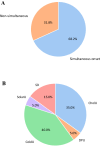Chronic inducible urticaria - having more than one is common and clinically relevant
- PMID: 40661948
- PMCID: PMC12256515
- DOI: 10.3389/fimmu.2025.1584771
Chronic inducible urticaria - having more than one is common and clinically relevant
Abstract
Background: Chronic inducible urticaria (CIndU) is characterized by wheals and/or angioedema (AE) for 6 weeks or more in response to specific and definite triggers. Individual patients can have more than one type of CIndU. Reports on this come from single cases or small case series, most epidemiological studies did not assess whether these urticaria are standalone or mixed.
Objective: Determine the features of mixed CIndU and how they differ from standalone forms.
Methods: In a prospective cohort study we performed provocative testing in 210 patients with CIndU. A total of 188 patients were included (125 with the standalone CIndU and 63 with the mixed CIndU. Within each group, patients were divided into subgroups: symptomatic dermographism (SD), cold (ColdU) and cholinergic urticaria (CholU).
Results: Mixed CIndU most commonly were SD+ColdU (n=19, 30.2%), SD+CholU (n=15, 23.8%), SD+DPU (n=12, 19%) and ColdU+CholU (n=9, 14.3%). Comorbid chronic spontaneous urticaria (CSU) (50.8% vs 20.8, p<0.001) and AE (36.5% vs. 20%, p=0.014) were more common in patients with mixed CIndUs. In patients with mixed CIndUs, their onset time is more closely linked to each other (n=43; 68.2%) as compared to that of comorbid CSU (12 of 32, 37.5%). MixedSD patients are younger, show earlier onset of disease and have higher rates of AE and lower rates of atopic dermatitis (AtD), as compared to patients with standalone SD. MixedColdU patients have higher rates of comorbid CSU and lower rates of AtD, higher levels of total IgE and eosinophils. MixedCholU patients are older, have a high rate of comorbid CSU, a lower incidence of allergic disease.
Conclusion: This study shows for the first time that each combinations of mixed CIndU represent a distinct phenotype with its own features. These phenotypes require special attention of specialists.
Keywords: angioedema; cholinergic urticaria; chronic inducible urticaria; cold urticaria; symptomatic dermographism; urticaria; wheal.
Copyright © 2025 Lebedkina, Kovalkova, Andrenova, Dushkin, Chernov, Nikitina, Karaulov, Lysenko, Maurer, Kocatürk and Fomina.
Conflict of interest statement
The authors declare that the research was conducted in the absence of any commercial or financial relationships that could be construed as a potential conflict of interest. The author(s) declared that they were an editorial board member of Frontiers, at the time of submission. This had no impact on the peer review process and the final decision.
Figures




References
-
- Magerl M, Altrichter S, Borzova E, Giménez-Arnau A, Grattan CE, Lawlor F, et al. The definition, diagnostic testing, and management of chronic inducible urticaria5/23/25 9:57:00 PMs - The EAACI/GA(2) LEN/EDF/UNEV consensus recommendations 2016 update and revision. Allergy. (2016) 71:780–802. doi: 10.1111/all.12884 - DOI - PubMed
MeSH terms
LinkOut - more resources
Full Text Sources
Medical
Research Materials

